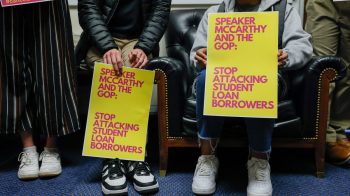
What’s behind Biden’s income-driven repayment plan for student loans?
What’s behind Biden’s income-driven repayment plan for student loans?

President Joe Biden’s recently announced student loan forgiveness plan is controversial. Yet the bigger, longer-term impact may well come from the administration’s student loan income-driven repayment plan. Assuming the initiative survives legal challenges, the new repayment plan would dramatically cut the cost of college.
“It would cut the amount borrowers pay back to go to college, and it would increase loan forgiveness,” Marketplace senior economics contributor Chris Farrell told Marketplace’s Sabri Ben-Achour. “Economist Adam Looney, in an analysis for the Brookings Institution, offers this back-of-the-envelope calculation: The cost to students to attend college, on average, could drop by some 50%.”
The following is an edited transcript of their conversation.
Sabri Ben-Achour: OK. “Income-driven repayment plans.” What is that?
Chris Farrell: These are plans that lower the monthly student loan-repayment bill, and students pay back their loans based on a percentage of their actual earnings and family size.
Ben-Achour: So what is different about the new one?
Farrell: Well, this one is a lot more generous. Specifically, focusing on undergraduates, borrowers would only pay 5% of their discretionary income. If the payment doesn’t cover interest charges, the government forgives the remaining interest. Any loan outstanding will be forgiven after 20 years, but the loan forgiveness period is only 10 years for those who borrowed $12,000 or less. Now the plan is only for federal loans. And there’s some other twists, but that’s the basic outline for undergraduates.
Ben-Achour: So bottom line: The bills people are paying for their college education, those bills go down?
Farrell: You know, the details are still emerging. But the initial calculations I’ve seen agree: It would cut the amount borrowers pay back to go to college, and it would increase loan forgiveness. Economist Adam Looney, in an analysis for the Brookings Institution, offers this back-of-the-envelope calculation: The cost to students to attend college, on average, could drop by some 50%.
Ben-Achour: This benefit, it’s directed at students. Does it do anything about the bigger problem, which is how expensive colleges and universities are?
Farrell: No, it only deals with half the equation. And there’s a lot of concern that this particular plan could lead to all kinds of negative consequences. For example, as you say, it does nothing to rein in what colleges and universities charge. And it could even create incentives to charge more. The budgetary cost to the federal government is also likely to be considerable. But here’s the thing. The administration’s student loan-forgiveness program, it’s a dramatic signal that the current student loan system is failing too many students. And there’s a group of reformers, and they’ve long coalesced around the idea of putting all existing and new student undergraduate borrowers into the kind of income-repayment system the administration has proposed. They also would like to see repayments automatically linked to the IRS and actual earnings. So this plan could represent a first step toward a vastly simpler and lower-cost way for students to pay for higher education compared to the current complicated, bureaucratic maze. But it’s only half the job.
There’s a lot happening in the world. Through it all, Marketplace is here for you.
You rely on Marketplace to break down the world’s events and tell you how it affects you in a fact-based, approachable way. We rely on your financial support to keep making that possible.
Your donation today powers the independent journalism that you rely on. For just $5/month, you can help sustain Marketplace so we can keep reporting on the things that matter to you.

















